Abstract
BACKGROUND:
Facial paralysis is defined as severe or complete loss of facial muscle motor function.
OBJECTIVE:
The study was undertaken to explore a bibliometric approach to quantitatively assess the research on clinical treatment of facial paralysis using rehabilitation, physiotherapy and acupuncture using Web of Science from 1992 to 2011.
DESIGN:
Bibliometric approach.
DATA RETRIEVAL:
A bibliometric analysis based on the publications on Web of Science was performed using key words such as “facial paralysis”, “rehabilitation”, “physiotherapy” and “acupuncture”.
INCLUSIVE CRITERIA:
(1) Research articles on the clinical treatment of facial paralysis using acupuncture or physiotherapy (e.g. exercise, electro-stimulation) and other rehabilitation methods; (2) researches on human and animal fundamentals, clinical trials and case reports; (3) Article types: article, review, proceedings paper, note, letter, editorial material, discussion, book chapter. (4) Publication year: 1992–2011 inclusive. Exclusion criteria: (1) Articles on the causes and diagnosis on facial paralysis; (2) Type of articles: correction; (3) Articles from following databases: all databases related to social science and chemical databases in Web of Science.
MAIN OUTCOME MEASURES:
(1) Overall number of publications; (2) number of publications annually; (3) number of citations received annually; (4) top cited paper; (5) subject categories of publication; (6) the number of countries in which the article is published; (7) distribution of output in journals.
RESULTS:
Overall population stands at 3 543 research articles addressing the clinical treatment of facial paralysis in Web of Science during the study period. There is also a markedly increase in the number of publications on the subject “facial paralysis treatments using rehabilitation” during the first decade of the 21st century, except in 2004 and 2006 when there are perceptible drops in the number of articles published. The only other year during the study period saw such a drop is 1993. Specifically, there are 192 published articles on facial paralysis treated by rehabilitation in the past two decades, far more than the output of physiotherapy treatment. Physiotherapy treatment scored only 25 articles including acupuncture treatment, with over 80% of these written by Chinese researchers and clinicians. Ranked by regions, USA is by far the most productive country in terms of the number of publications on facial paralysis rehabilitation and physiotherapy research. Seeing from another angle, the journals that focus on otolaryngology published the most number of articles in rehabilitation and physiotherapy studies, whereas most acupuncture studies on facial paralysis were published in the alternative and complementary medicine journals.
CONCLUSION:
Study of facial paralysis remains an area of active investigation and innovation. Further clinical studies in humans addressing the use of growth factors or stem cells continue to successful facial nerve regeneration.
Keywords: facial paralysis, treatment, physiotherapy, acupuncture, Web of Science, literature, bibliometric
INTRODUCTION
This study is designed to compare the three different methods of clinical treatment on facial paralysis from published research papers found on ISI Web of Science (WOS) from 1992 to 2011. The bibliometric approach is used to quantitatively analyze the distribution patterns of the authorship, publication metrics, and citations of literatures, and to investigate research trends of specific fields and to guide studying the clinical treatment of facial paralysis.
Facial paralysis is defined as severe or complete loss of facial muscle motor function. This condition may result from central or peripheral lesions. Damage to central neural system motor pathways from the cerebral cortex to the facial nuclei in the pons leads to facial weakness that generally spares the forehead muscles.
The occurrences of facial paralysis can be found in any age group, with unilateral facial affect in most cases. Its onset is marked by the sudden paralysis of facial expression muscles of the affected side, shallower forehead wrinkles, failure of the eyelid of the affected side in complete closure, lacrimation and salivation, and mouth deviation toward the healthy side[1].
The pathological manifestations of facial paralysis is facial nerve edema and amyelination, accompanied by axonal degeneration in some advanced patients. The facial periphery nerve paralysis is generally considered to be induced by spasm, ischemia, edema, or virus infection of local vessels nourishing the nerve[2].
Increasingly, with the development of the exercise rehabilitation, attention is focused on the irreplaceable effects of physiotherapy on promoting functional recovery of facial nerves[3,4,5]. Early physiotherapy can reduce or lead to the abatement of the severity of incompatible movement, facilitate recovery of facial expression, as well as enhance facial muscles’ strength[6].
The first article addressing physiotherapy related to facial paralysis indexed in WOS is titled “An immediate combined approach for rehabilitation of patient with facial paralysis”, which was published by Freeman, BS and published in Plastic and Reconstructive Surgery in 1966[7].
Acupuncture is also widely used in Asian countries, although only limited trials have been reported in treating facial paralysis[8]. Sseveral studies provided some evidence for the benefits of acupuncture and moxibustion as auxiliary treatment methods of facial paralysis[9,10]. During the trial, acupuncture treatment formulae for facial nerve palsy are analysed. It is found that in many cases, acupuncture points traditionally associated with the treatment share similar neuro-anatomical significance. Acupuncture is used to relieve initial symptoms, to encourage neuromuscular retraining which in turn lead to a quicker recovery when the nerve regenerates. The mechanisms for acupuncture include intramuscular stimulation for treating muscular pain and nerve stimulation for treating neuropathies[11].
Based on the search of WOS, the first article published on acupuncture of facial paralysis is titled “Successful treatment of facial paralysis with acupuncture”, by Wong LP and published in American Journal of Acupuncture in 1986[12].
DATA SOURCES AND METHODOLOGY
Design
Bibliometric study.
Time and setting
The study was performed at the library of State Key Laboratory of Oral Diseases, Sichuan University at 2011-10-08.
Data retrieval
The search was primarily undertaken from the online version of the Science Citation Index Expanded (SCI-E, 1899–present), accessed via WOS, Philadelphia, PA, USA. According to Thomson Reuters, SCI-E indexed 8 436 major journals with citation references across 173 scientific disciplines in 2011. SCI-E is considered as one of the most comprehensive and relevant coverage of bibliometric information and journals, which enables researchers to find data, to analyze trends, cross referencing journals and researchers.
WOS was searched to determine the number of articles published on various clinical treatments on facial paralysis, especially using rehabilitation, physiotherapy and acupuncture.
Inclusion criteria
Articles studied on the clinical treatment on facial paralysis with acupuncture or physiotherapy (e.g. exercise, electro-stimulation) and other rehabilitation methods.
Research on human and animal fundamentals, clinical trials and case reports.
Type of articles includes articles, reviews, proceedings paper, notes, letter, editorial material, discussion and book chapters.
Year of publication: 1992/2011 inclusive.
Citation databases: SCI-E --1899-present; Conference Proceedings Citation Index-Science (CPCI-S) --1991-present; Book Citation Index-Science (BKCI-S) --2005-present.
Exclusion criteria
Articles on the causes and diagnosis on facial paralysis.
Type of articles: Correction.
Articles from following databases: Social Sciences Citation Index (SSCI) --1898-present; Arts & Humanities Citation Index (A&HCI) --1975-present; Conference Proceedings Citation Index- Social Science & Humanities (CPCI-SSH) --1991-present; Book Citation Index- Social Sciences & Humanities (BKCI-SSH) --2005-present; Current Chemical Reactions (CCR-EXPANDED) --1985-present; Index Chemicus (IC) --1993-present.
Keywords used for facial paralysis treatment
(1) Facial paralysis and rehabilitation; (2) Facial paralysis and physiotherapy not acupuncture; (3) Facial paralysis and acupuncture.
The analysis combined WOS data and statistic functions in MS Excel. The outcomes of all articles referring to treatment on facial paralysis were selected and analyzed using the following measurements: (1) overall number of publications; (2) number of publications annually; (3) number of citations received annually; (4) top cited paper; (5) subject categories of publication; (6) the number of countries in which the article is published; (7) distribution of output in journals.
RESULTS
Overall publication output on facial paralysis treatment included in web of science during 1992 and 2011 (Table 1)
Table 1.
Total number of publications in Web of Science referring to keywords “facial paralysis”, “rehabilitation”, “physiotherapy” and “acupuncture” during last 20 years
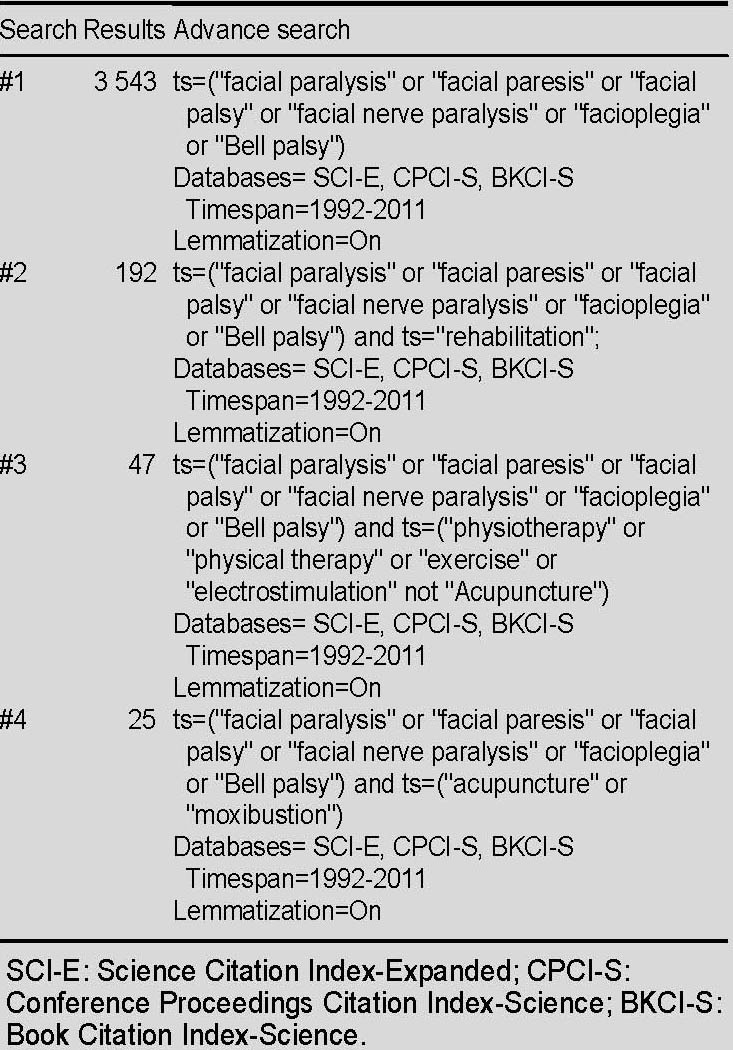
The total number of publication on clinical treatment of facial paralysis was recorded in SCI-E (1899–present), CPCI-S (1991–present) and BKCI-S (2005–present). In total, 192 articles were found on facial paralysis rehabilitation, of which there are 47 articles on the physiotherapy on facial paralysis in the past two decades. Due to the language and journal selection constraints, there was limited number of articles found on the study of acupuncture treatment on facial paralysis. Correction articles were excluded from the search.
Annual publication output on facial paralysis treatment in web of science between 1992 and 2011
The distribution of annual publication output is shown in The publication on facial paralysis rehabilitation treatment increased between 1990s and 2010s. However, there are a number of years which saw dramatic drops in the number of paper published, namely 1993, 2004 and 2006. Overall, the number of articles on clinical treatment on facial paralysis using rehabilitation has gradually increased during the past 20 years. More than 20 articles were published on the facial paralysis rehabilitation research in 2011, nearly doubling the annual average during the entire period (Figures 1–3).
Figure 1.
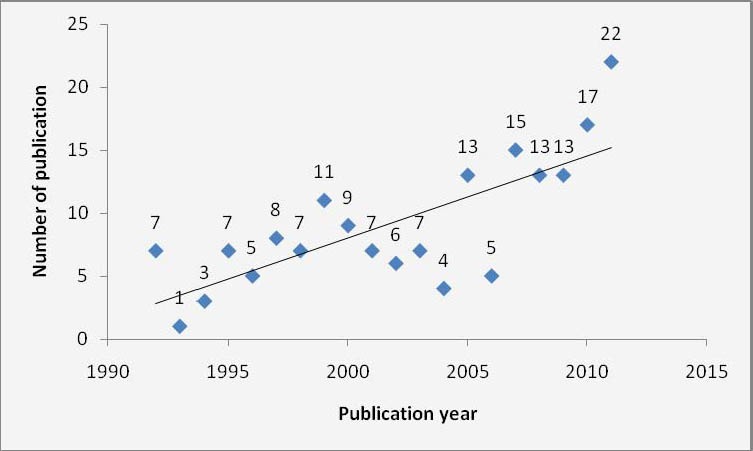
The distribution of annual publication output of facial paralysis rehabilitation.
Figure 3.
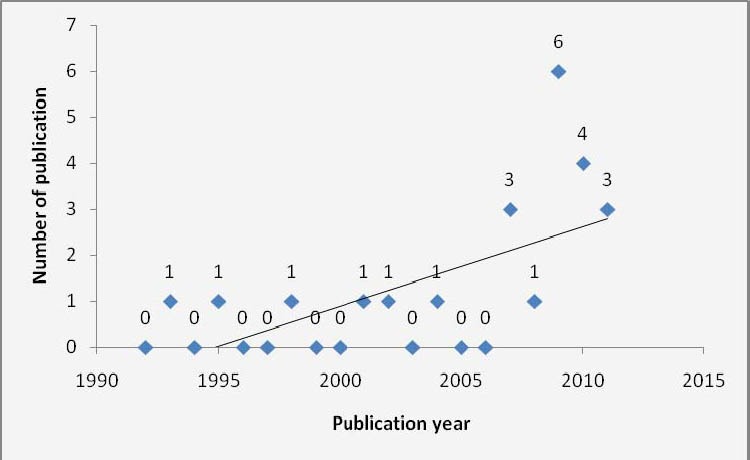
The distribution of annual publication output of Acupuncture treatment on facial paralysis.
Figure 2.
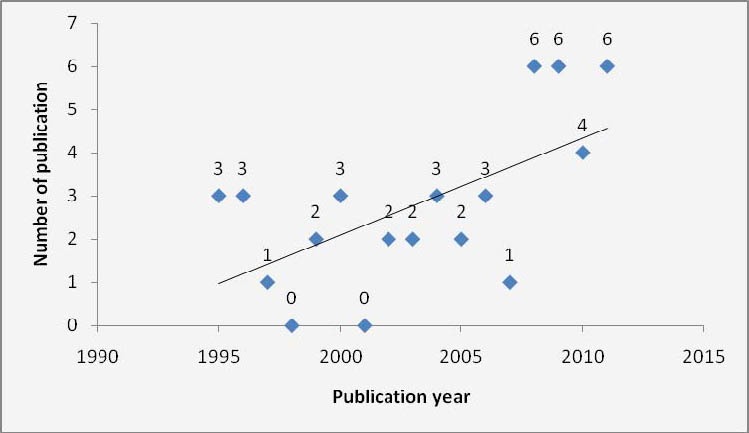
The distribution of annual publication output of physiotherapy treatment on facial paralysis.
There was no articles on facial paralysis treatment using physiotherapy found on WOS in 1998 and 2001. It is interesting that a increasing number of paper were published in recent years, of which six articles were searched to discuss the physical therapy on facial paralysis in 2008, 2009 and 2011.
Selected from 25 articles on acupuncture study on facial paralysis, which were included in web of science between 1992 and 2011, The highest number of articles published, totalling six in a year was recorded in 2009. There were nine years in which no paper were selected and indexed in the research area in web of science. Average number of paper published in is 1.25 per annum.
Annual citation performance of publications on facial paralysis treatment in web of science between 1992 and 2011
Total numbers cited displays the total number of citations (cited references) to all of the articles found in the results set. Total time cited without self-citations displays the total number of cited references to all of the items found in the results set minus any citation from articles in the set (Figures 4–6).
Figure 4.
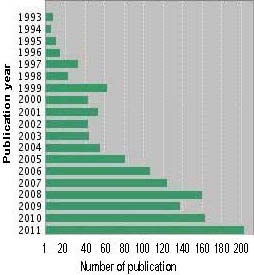
Annual citation of publication on facial paralysis rehabilitation.
Figure 6.
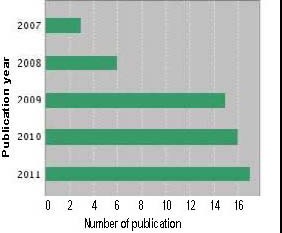
Annual citation of publication on acupuncture treatment on facial paralysis.
Figure 5.
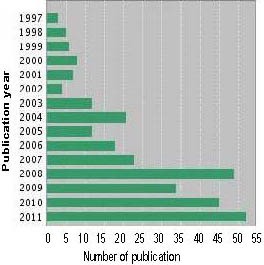
Annual citation of publication on facial paralysis treated by physiotherapy.
Totally 192 articles published on facial paralysis rehabilitation treatment were selected from WOS. The total number of citations on the publications are 1 421 times by 878 articles, and 1 080 times without self-citations by 768 articles. Average citations rate is 7.4 per article, whereas every articles on the related research were cited by 7.4 times in the past. Based on the results, there are over 20 articles which were cited more than 20 times on WOS between 1992 and 2011.
A total of 47 articles studying physiotherapy on facial paralysis were selected from WOS and were cited 300 times by 261 articles. Average rate of citation is 6.38 during the entire study time frame. Based on the search, there are over nine articles which are cited over nine times on WOS.
There were 25 articles studying acupuncture on facial paralysis found on WOS, which were cited 57 times by 53 articles. Average number of citing articles was 2.28 times between 1992 and 2011. The most popular article was cited 17 times overall, which was published in October 2004. The highest impact paper was cited five time in 2009.
Distribution of subject areas of facial paralysis treatment included in web of science during 1992 and 2011
Based on the classification of subject areas on WOS, the article output data was grouped into 173 subject categories. The articles of the top 10 related subject categories in the research were analyzed in Table 2.
Table 2.
Distribution of subject areas of facial paralysis treatment included in Web of Science from 1992 to 2011
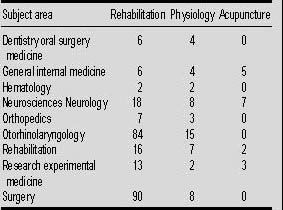
From Table 2, the distribution of subject categories showed that most studies on both rehabilitation and physiotherapy treatment on facial paralysis were related to the surgery and otorhinolaryngology. Moreover, acupuncture studies were generally found under researches in neurosciences neurology and general internal medicine.
Top cited publication on clinical treatment on facial paralysis included in web of science from 1992 and 2011 (Tables 3–5)
Table 3.
Top cited paper on facial paralysis rehabilitation
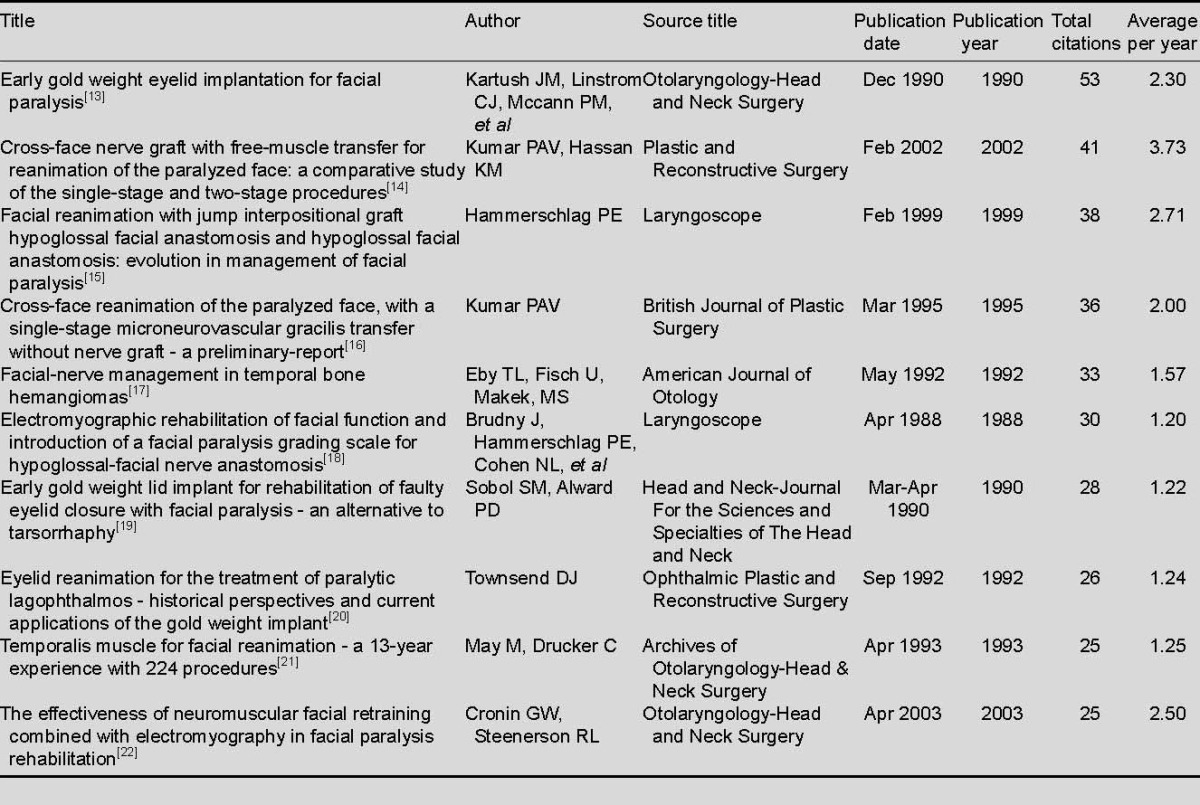
Table 5.
Top cited paper on facial paralysis treatment using Acupuncture
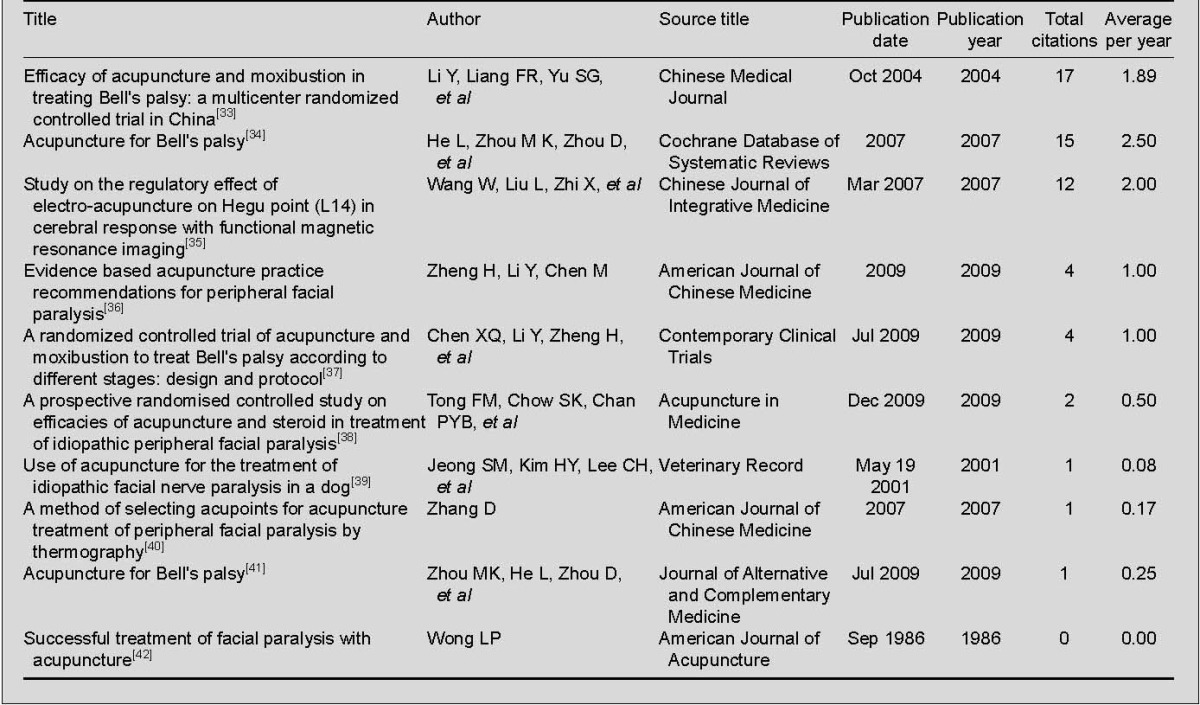
Table 4.
Top cited paper on facial paralysis treatment using physiotherapy
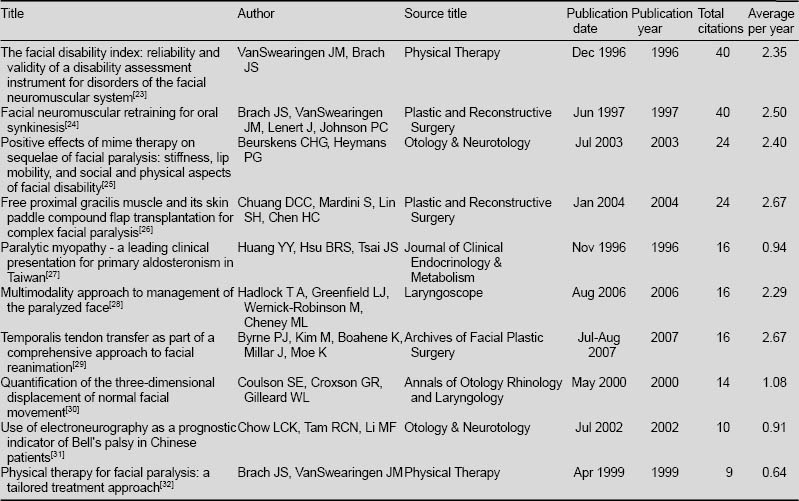
Below is a list of the most popular paper studying facial paralysis treatment, ranked based on the number of citations they scored on WOS between 1992 and 2011. Top cited paper does not necessarily equal to the highest impact paper on a annual basis. The immediate impact in the year when they were published is indicated by the average citation per annum or the citation during each year.
Type of publications of facial paralysis treatment included in web of science during 1992 and 2011
The distribution of document types identified by WOS was analysed. Seven document types were found in the selected publications in facial paralysis treatment between 1992 and 2011, including articles, reviews, proceedings paper, editorial material, meeting abstracts, book chapters and notes. Correction paper was excluded for further analysis.
Over 80% on facial paralysis rehabilitation was published as original article, totalling 173 publications on WOS between 1992 and 2011. In addition, 30 proceeding paper were published and included regarding the facial paralysis rehabilitation. There were only seven review paper on the study.
Forty-two out of 47 publications were published as original articles in the physiotherapy study on facial paralysis in web of science during 1992 and 2011, followed by three proceedings papers, two reviews and two letters.
Totally 25 articles were published on acupuncture treatment of facial paralysis, which included 18 original articles, three reviews, two proceedings papers and two meeting abstracts.
Distribution of output in countries (Table 6)
Table 6.
Top 10 countries of publication output in clinical treatment on facial paralysis between 1992 and 2011

USA, France and Brazil are the three countries with the highest output in terms of total number published in facial paralysis rehabilitation studies. USA also published most number of paper in physiotherapy treatment in facial paralysis. However, when it comes to facial paralysis treatment using acupuncture, China is the absolute number one country, followed by the US and South Korea which published a number of articles in physiotherapy and acupuncture treating facial paralysis.
Distribution of output in journals (Tables 7–9)
Table 7.
Top five journals published on facial paralysis rehabilitation treatment
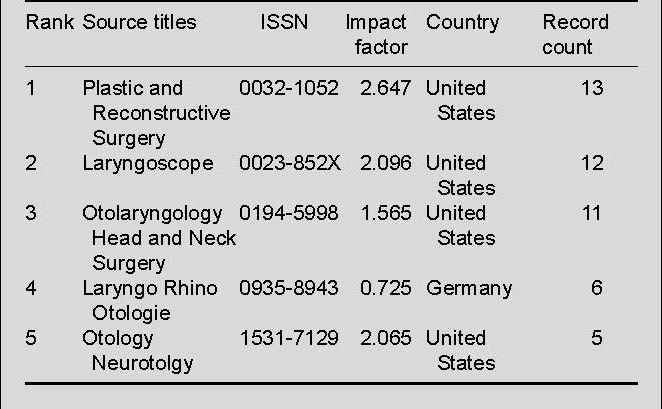
Table 9.
Top five journals published on facial paralysis treatment using acupuncture

Table 8.
Top five journals published on facial paralysis treatment using physiotherapy
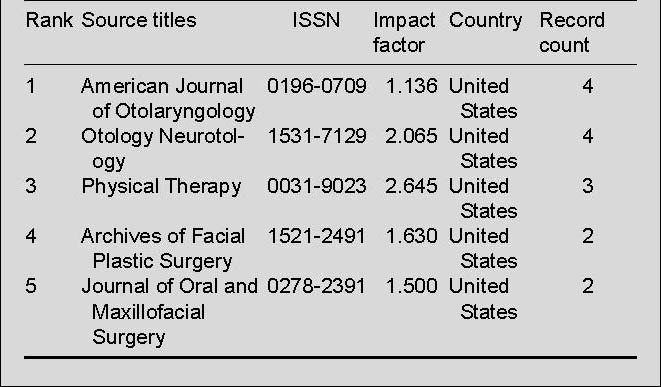
Top five journals were selected based on the number of publications on the research in web.
Research on facial paralysis rehabilitation mainly published in the following journals indexed on WOS, including Plastic and Reconstructive Surgery, Laryngoscope, Otolaryngology Head and Neck Surgery, Laryngo Rhino Otologie and Otology Neurotolgy.
Research on clinical treatment of physiotherapy on facial paralysis was covered and published in similar journals as rehabilitation studies, where American journal of otolaryngology was published most from 1992 to 2011.
Most acupuncture studies on facial paralysis were published in the alternative and complementary medicine journals, which focused on the studies of traditional Chinese medicines.
DISCUSSION
Based on the bibliometric analysis, following comparison and results can be made among different treatments on facial paralysis.
First, there are 3 543 research articles addressing clinical treatment of facial paralysis included in Web of science during 1992 to 2011. Totally 192 articles on facial paralysis treated by rehabilitation were published in the past two decades, and the average citation rate for each paper is 1.28 times per annum. The research on facial paralysis rehabilitation is attracting an ever increasing attention among the global researchers in the first decade of the 21st century, notwithstanding the large drops in outputs in 1993, 2004 and 2006.
Second, the number of publication on physiotherapy of facial paralysis was far less than the number of publication on rehabilitation studies, but exceeds the number of publication on acupuncture studies.
Third, because of limited journal selection on acupuncture and traditional Chinese medicine included in WOS, there are only 25 articles that can be retrieved in acupuncture treatment, of which 80% of them were published by Chinese researchers and clinicians.
Fourth, the authors and institutes in USA have published most of articles in the studies of rehabilitation and physiotherapy on facial paralysis.
Last but not the least, the journals focusing in otolaryngology published most articles in rehabilitation and physiotherapy studies. Most acupuncture studies on facial paralysis were published in the alternative and complementary medicine journals.
Footnotes
Conflicts of interest: None declared.
(Edited by Jiang XF, Zhao M/Wang L)
REFERENCES
- [1].Ruan WL. Ultrashort wave combined acupoint iontophoresis for the treatment of facial paralysis. Zhongguo Kangfu. 2004;19(4):241–241. [Google Scholar]
- [2].Yamakawa T, Yoshikawa H, Arai A, et al. A clinical study on the magnetic stimulation of the facial nerve. Laryngoscope. 1999;109(3):492–497. doi: 10.1097/00005537-199903000-00028. [DOI] [PubMed] [Google Scholar]
- [3].Piron L, Turolla A, Agostini M, et al. Exercises for paretic upper limb after stroke: a combined virtual-reality and telemedicine approach. J Rehabil Med. 2009;41(12):1016–1102. doi: 10.2340/16501977-0459. [DOI] [PubMed] [Google Scholar]
- [4].Shafshak TS. The treatment of facial palsy from the point of view of physical and rehabilitation medicine. Eura Medicophys. 2006;42(1):41–47. [PubMed] [Google Scholar]
- [5].Oliveira LS, Sobral LL, Takeda SY, et al. Electrical stimulation and swimming in the acute phase of axonotmesis: their influence on nerve regeneration and functional recovery. Rev Neurol. 2008;47(1):11–15. [PubMed] [Google Scholar]
- [6].Freeman BS. An immediate combined approach for rehabilitation of the patient with facial paralysis. Plast Reconstr Surg. 1966;37(4):341–345. doi: 10.1097/00006534-196604000-00009. [DOI] [PubMed] [Google Scholar]
- [7].Cheng KJ. Neuroanatomical basis of acupuncture treatment for some common illnesses. Acupunct Med. 2009;27(2):61–64. doi: 10.1136/aim.2009.000455. [DOI] [PubMed] [Google Scholar]
- [8].Piron L, Turo lla A, Agostini M, et al. Ex ercises for pareticupper limb after stroke: a combined virtual- reality and telemedicine approach. J Rehabil Med. 2009;41(12):1016–1102. doi: 10.2340/16501977-0459. [DOI] [PubMed] [Google Scholar]
- [9].Liang F, Li Y, Yu S, et al. A multicentral randomized control study on clinical acupuncture treatment of Bell's palsy. J Tradit Chin Med. 2006;26:3–7. [PubMed] [Google Scholar]
- [10].Qu Y. Clinical observation on acupuncture by stages combined with exercise therapy for treatment of Bell palsy at acute stage. Zhongguo Zhen Jiu. 2005;25:545–547. [PubMed] [Google Scholar]
- [11].Ma YW, Dong JC, Du BZ, et al. Effect of facial muscle movement on functional recovery of idiopathic facial paralysis. Zhongguo Kangfu Yixue Zazhi. 2009;24(6):543–546. [Google Scholar]
- [12].Wong LP. Successful treatment of facial paralysis with acupuncture. Am J Acupunct. 1986;14(3):217–223. [Google Scholar]
- [13].Kartush JM, Linstrom CJ, McCann PM, et al. Early gold weight eyelid implantation for facial paralysis. Otolaryngol Head Neck Surg. 1990;103(6):1016–1023. doi: 10.1177/019459989010300622. [DOI] [PubMed] [Google Scholar]
- [14].Kumar PA, Hassan KM. Cross-face nerve graft with free-muscle transfer for reanimation of the paralyzed face: a comparative study of the single-stage and two-stage procedures. Plast Reconstr Surg. 2002;109(2):451. doi: 10.1097/00006534-200202000-00006. [DOI] [PubMed] [Google Scholar]
- [15].Hammerschlag PE. Facial reanimation with jump interpositional graft hypoglossal facial anastomosis and hypoglossal facial anastomosis: evolution in management of facial paralysis. Laryngoscope. 1999;109(2 Pt 2 Suppl 90):1–23. doi: 10.1097/00005537-199902001-00001. [DOI] [PubMed] [Google Scholar]
- [16].Kumar PA. Cross-face reanimation of the paralysed face, with a single stage microneurovascular gracilis transfer without nerve graft: a preliminary report. Br J Plast Surg. 1995;48(2):83–88. doi: 10.1016/0007-1226(95)90101-9. [DOI] [PubMed] [Google Scholar]
- [17].Eby TL, Fisch U, Makek MS. Facial nerve management in temporal bone hemangiomas. Am J Otol. 1992;13(3):223–232. [PubMed] [Google Scholar]
- [18].Brudny J, Hammerschlag PE, Cohen NL, et al. Electromyographic rehabilitation of facial function and introduction of a facial paralysis grading scale for hypoglossal-facial nerve anastomosis. Laryngoscope. 1988;98(4):405–410. doi: 10.1288/00005537-198804000-00010. [DOI] [PubMed] [Google Scholar]
- [19].Sobol SM, Alward PD. Early gold weight lid implant for rehabilitation of faulty eyelid closure with facial paralysis: an alternative to tarsorrhaphy. Head Neck. 1990;12(2):149–153. doi: 10.1002/hed.2880120210. [DOI] [PubMed] [Google Scholar]
- [20].Townsend DJ. Eyelid reanimation for the treatment of paralytic lagophthalmos: historical perspectives and current applications of the gold weight implant. Ophthal Plast Reconstr Surg. 1992;8(3):196–201. doi: 10.1097/00002341-199209000-00006. [DOI] [PubMed] [Google Scholar]
- [21].May M, Drucker C. Temporalis muscle for facial reanimation. A 13-year experience with 224 procedures. Arch Otolaryngol Head Neck Surg. 1993;119(4):378–382. doi: 10.1001/archotol.1993.01880160022004. discussion 383-384. [DOI] [PubMed] [Google Scholar]
- [22].Cronin GW, Steenerson RL. The effectiveness of neuromuscular facial retraining combined with electromyography in facial paralysis rehabilitation. Otolaryngol Head Neck Surg. 2003;128(4):534–548. doi: 10.1016/S0194-59980300005-6. [DOI] [PubMed] [Google Scholar]
- [23].VanSwearingen JM, Brach JS. The Facial Disability Index: reliability and validity of a disability assessment instrument for disorders of the facial neuromuscular system. Phys Ther. 1996;76(12):1288–1298. doi: 10.1093/ptj/76.12.1288. discussion 1298-1300. [DOI] [PubMed] [Google Scholar]
- [24].Brach JS, VanSwearingen JM, Lenert J, et al. Facial neuromuscular retraining for oral synkinesis. Plast Reconstr Surg. 1997;99(7):1922–1931. doi: 10.1097/00006534-199706000-00017. [DOI] [PubMed] [Google Scholar]
- [25].Beurskens CH, Heymans PG. Positive effects of mime therapy on sequelae of facial paralysis: stiffness, lip mobility, and social and physical aspects of facial disability. Otol Neurotol. 2003;24(4):677–681. doi: 10.1097/00129492-200307000-00024. [DOI] [PubMed] [Google Scholar]
- [26].Chuang DC, Mardini S, Lin SH, et al. Free proximal gracilis muscle and its skin paddle compound flap transplantation for complex facial paralysis. Plast Reconstr Surg. 2004;113(1):126–132. doi: 10.1097/01.PRS.0000096092.09655.63. [DOI] [PubMed] [Google Scholar]
- [27].Huang YY, Hsu BR, Tsai JS. Paralytic myopathy--a leading clinical presentation for primary aldosteronism in Taiwan. Clin Endocrinol Metab. 1996;81(11):4038–4041. doi: 10.1210/jcem.81.11.8923857. [DOI] [PubMed] [Google Scholar]
- [28].Hadlock TA, Greenfield LJ, Wernick-Robinson M, et al. Multimodality approach to management of the paralyzed face. Laryngoscope. 2006;116(8):1385–1389. doi: 10.1097/01.mlg.0000225980.38147.c6. [DOI] [PubMed] [Google Scholar]
- [29].Byrne PJ, Kim M, Boahene K, et al. Temporalis tendon transfer as part of a comprehensive approach to facial reanimation. Arch Facial Plast Surg. 2007;9(4):234–241. doi: 10.1001/archfaci.9.4.234. [DOI] [PubMed] [Google Scholar]
- [30].Coulson SE, Croxson GR, Gilleard WL. Quantification of the three-dimensional displacement of normal facial movement. Ann Otol Rhinol Laryngol. 2000;109(5):478–483. doi: 10.1177/000348940010900507. [DOI] [PubMed] [Google Scholar]
- [31].Chow LC, Tam RC, Li MF. Use of electroneurography as a prognostic indicator of Bell's palsy in Chinese patients. Otol Neurotol. 2002;23(4):598–601. doi: 10.1097/00129492-200207000-00033. [DOI] [PubMed] [Google Scholar]
- [32].Brach JS, VanSwearingen JM. Physical therapy for facial paralysis: a tailored treatment approach. Phys Ther. 1999 Apr;79(4):397–404. [PubMed] [Google Scholar]
- [33].Li Y, Liang FR, Yu SG, et al. Efficacy of acupuncture and moxibustion in treating Bell's palsy: a multicenter randomized controlled trial in China. Chin Med J (Engl) 2004;117(10):1502–1506. [PubMed] [Google Scholar]
- [34].He L, Zhou MK, Zhou D, et al. Acupuncture for Bell's palsy. Cochrane Database Syst Rev. 2007;4:CD002914. doi: 10.1002/14651858.CD002914.pub3. [DOI] [PubMed] [Google Scholar]
- [35].Wang W, Liu L, Zhi X, et al. Study on the regulatory effect of electro-acupuncture on hegu point (LI4) in cerebral response with functional magnetic resonance imaging. Chin J Integr Med. 2007;13(1):10–16. doi: 10.1007/s11655-007-0010-3. [DOI] [PubMed] [Google Scholar]
- [36].Zheng H, Li Y, Chen M. Evidence based acupuncture practice recommendations for peripheral facial paralysis. Am J Chin Med. 2009;37(1):35–43. doi: 10.1142/S0192415X09006631. [DOI] [PubMed] [Google Scholar]
- [37].Chen X, Li Y, Zheng H, Hu K, et al. A randomized controlled trial of acupuncture and moxibustion to treat Bell's palsy according to different stages: design and protocol. Contemp Clin Trials. 2009;30(4):347–353. doi: 10.1016/j.cct.2009.02.006. [DOI] [PubMed] [Google Scholar]
- [38].Tong FM, Chow SK, Chan PY, et al. A prospective randomised controlled study on efficacies of acupuncture and steroid in treatment of idiopathic peripheral facial paralysis. Acupunct Med. 2009;27(4):169–173. doi: 10.1136/aim.2009.000638. [DOI] [PubMed] [Google Scholar]
- [39].Jeong SM, Kim HY, Lee CH, et al. Use of acupuncture for the treatment of idiopathic facial nerve paralysis in a dog. Vet Rec. 2001;19(148) 20:632–633. doi: 10.1136/vr.148.20.632. [DOI] [PubMed] [Google Scholar]
- [40].Zhang D. A method of selecting acupoints for acupuncture treatment of peripheral facial paralysis by thermography. Am J Chin Med. 2007;35(6):967–975. doi: 10.1142/S0192415X07005430. [DOI] [PubMed] [Google Scholar]
- [41].Zhou M, He L, Zhou D, et al. Acupuncture for Bell's palsy. J Altern Complement Med. 2009;15(7):759–764. doi: 10.1089/acm.2008.0179. [DOI] [PubMed] [Google Scholar]
- [42].Wong LP. Successful treatment of facial paralysis with acupuncture. Am J Acupunct. 1986;14(3):217–223. [Google Scholar]


